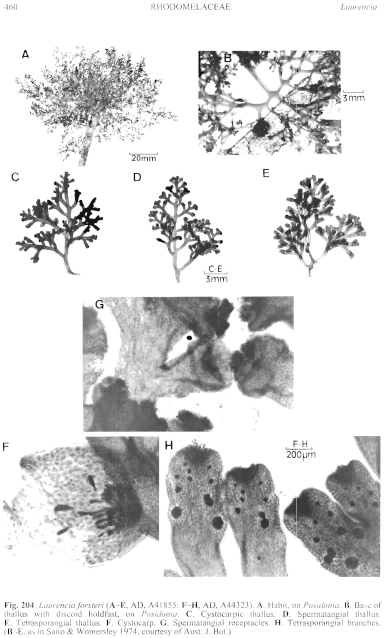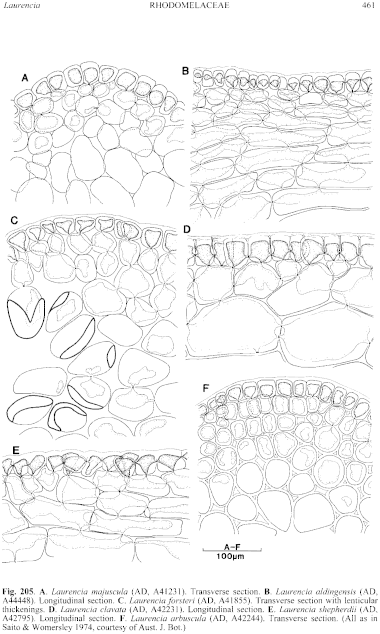|
|
|
|
|
|||||||||||
|
Electronic Flora of South Australia Species Fact Sheet
Phylum Rhodophyta – Family Rhodomelaceae – Tribe Laurencieae
Selected citations: J. Agardh 1852: 744 (in part); 1876: 645. De Toni 1896: 227; 1903: 779. De Toni & Forti 1923: 36. Ducker et al. 1977: 87. Guiler 1952: 105. Harvey 1849a: 85; 1855a: 544; 1859b: 306(?); 1863, synop. xxv. Hooker & Harvey 1847: 401. Huisman & Walker 1990: 437. Kützing 1849: 854. Lucas 1909: 38 (in part); 1929a: 21; 1929b: 50. Lucas & Perrin 1947: 247 (in part). Saito & Womersley 1974: 823 figs 1E, 8. Reinbold 1899: 47? Saenger 1974: 81. Shepherd & Womersley 1971: 166. Silva et al. 1996: 511. Sonder 1848: 178 (f. vera only). Sonder 1853: 694; 1855: 523; 1880: 29. Tate 1882a: 22. Tepper 1883: 66. Tisdall 1898: 512. Wilson 1892: 169. Yamada 1931: 213, pl. 13a.
Synonyms
Fucus forsteri Mertens ex Turner 1809: 16, pl. 77.
Chondria forsteri (Mertens ex Turner)C. Agardh 1822: 343; 1824: 203.
Thallus (Fig. 204A) red to red-brown, moderately soft, 2–6 (–8) cm high, slender, spreading with radial, terete branches at wide angles, mostly 2–5 mm apart; lower branches 0.5–1 mm in diameter, decreasing to 300–500 1 µm in branchlets. Holdfast (Fig. 204B) flat, discoid, 1–3 mm across; epiphytic on Posidonia, occasionally Amphibolis. Structure. Epidermal cells near apices (Fig. 205C) polygonal to slightly elongate, 15–20 µm across, enlarging below to 20–30 (–50) broad and L/D 3–5 (–8), with secondary pit-connections and corps en cerise; lenticular thickenings (Fig. 205C) usually abundant in inner cortical cells. Cells uninucleate, multinucleate in larger cells; rhodoplasts discoid, chained in larger cells.
Reproduction: Gametophytes dioecious. Procarps not observed. Carposporophytes with a small basal fusion cell and short branched gonimoblast bearing clavate carposporangia 30–60 µm in diameter. Cystocarps (Fig. 204C, F) sessile, globular and urceolate, with broad, slightly constricted bases, (300–) 500–1100 µm in diameter; pericarp ostiolate, 2–3 cells thick, with a distinct neck 100–150 µm high. Spermatangial receptacles (Fig. 204D) terminating clavate to pyriform branchlets, 300–700 µm across, spermatangia borne on trichoblasts.
Tetrasporangia (Fig. 204E, H) in simple or compound, clavate, branchlets 400–700 µm broad and 0.5–1 (–2) mm long, in parallel arrangement and cut off abaxially, 120–220 µm in diameter.
Type from "Coast of Australia" (probably King George Sound, W. Aust.), Menzies; holotype in BM.
Selected specimens: Safety Bay, W. Aust., on Posidonia sinuosa, drift (Cribb 68.4, 14.viii.1950; AD, A13974). Lucky Bay, Cape LeGrand, W. Aust., on Posidonia australis, upper sublittoral (Womersley, 4.x.1979; AD, A51163). Coffin Bay, S. Aust., on P. sinuosa, 2.5 m deep (Womersley, 4.xii.1975; AD, A46937). Tiparra Reef, S. Aust., on P. sinuosa, 11 m deep (Shepherd, 29.i.1972; AD, A41853). Aldinga, S. Aust., on P. sinuosa, upper sublittoral (Saito, 27.ii.1972; AD, A41855); on P. sinuosa, 5–6 m deep (Johnson, 7.vii.1973; AD, A44323-"Marine Algae of southern Australia" No. 164); and on Amphibolis leaf (Shepley, 13.x.1954; AD, A20189). Second Valley, S. Aust., on P. sinuosa, 3–4 m deep (Womersley, 19.i.1973; AD, A42961). Emu Bay, Kangaroo I., S. Aust., on P. sinuosa (Womersley, 18.i.1945; AD, A2686). Muston, American R. inlet, Kangaroo I., S. Aust., on P. australis, 2–3 m deep (Kraft, 12.iv.1973; AD, A43712). Adelaide Bay, Flinders I., Bass Strait, on Posidonia, 0–2 m deep (Blackman, 30.i.1978; AD, A49235). Low Head, Tas., on P. australis (Perrin, 11.ix.1937; AD, A8993).
Distribution: Houtmann Abrolhos, W. Aust., to Wilson Prom., Vic. (Sonder) and N Tasmania.
Taxonomic notes: Laurencia forsteri is a distinctive species, confined largely to the leaves of Posidonia (occasionally Amphibolis) in conditions of moderate water movement. Probably some references to L. forsteri should apply to forms of L. filiformis.
The West Australian L. cymosa Kützing (1865, p. 21, p1. 57c, d), type in L, 941, 119 ...121 (a Preiss specimen), may be identical with L. forsteri. They are very similar in habit, and the comment of Saito & Womersley (1974, p. 825) that L. cymosa "completely lacks lenticular thickenings" is doubtfully true since some specimens (e.g. "Marine Algae of southern Australia" No. 213), distributed as L. cymosa, do have abundant wall thickenings.
References:
AGARDH, C.A. (1822). Species Algarum. Vol. 1, Pt 2, pp. 169–398. (Berling: Lund.)
AGARDH, C.A. (1824). Systema Algarum. (Berling: Lund.)
AGARDH, J.G. (1852). Species Genera et Ordines Algarum. Vol. 2, Part 2, pp. 337–720. (Gleerup: Lund.)
AGARDH, J.G. (1876). Species Genera et Ordines Algarum. Vol. 3, Part 1 - Epicrisis systematis Floridearum, pp. i-vii, 1–724. (Weigel: Leipzig.)
DE TONI, G.B. & FORTI, A. (1923). Alghe di Australia, Tasmania e Nouva Zelanda. Mem. R. Inst. Veneto Sci., Lett. Arti 29, 1–183, Plates 1–10.
DE TONI, G.B. (1896). Pugillo di alghe Australiane Raccolte all'isola di Flinders. Boll. Soc. Bot. Ital. 1896, 224–231.
DE TONI, G.B. (1903). Sylloge Algarum omnium hucusque Cognitarum. Vol. 4. Florideae. Sect. 3. pp. 775–1521 + 1523–1525. (Padua.)
DUCKER, S.C., FOORD, N.J. & KNOX, R.B. (1977). Biology of Australian Seagrasses: the genus Amphibolis C. Agardh (Cymodoceaceae). Aust. J. Bot. 25, 67–95.
GREVILLE, R.K. (1830). Algae Britannicae. (Maclachlan & Stewart: Edinburgh.)
GUILER, E.R. (1952). The marine algae of Tasmania. Checklist with localities. Pap. Proc. R. Soc. Tasmania 86, 71–106.
HARVEY, W.H. (1849a). Nereis Australis, pp. 65–124, Plates 26–50. (Reeve: London.)
HARVEY, W.H. (1855a). Some account of the marine botany of the colony of Western Australia. Trans. R. Jr. Acad. 22, 525–566.
HARVEY, W.H. (1859b). Algae. In Hooker, J.D., The Botany of the Antarctic Voyage. III. Flora Tasmaniae. Vol. II, pp. 282–343, Plates 185–196. (Reeve: London.)
HARVEY, W.H. (1863). Phycologia Australica. Vol. 5, Plates 241–300, synop., pp. i-lxxiii. (Reeve: London.)
HOOKER, J.D. & HARVEY, W.H. (1847). Algae Tasmanicae. Lond. J. Bot. 6, 397–417.
HUISMAN, J.M. & WALKER, D.I. (1990). A catalogue of the marine plants of Rottnest Island, Western Australia, with notes on their distribution and biogeography. Kingia 1, 349–459.
KÜTZING, F.T. (1849). Species Algarum. (Leipzig.)
KÜTZING, F.T. (1865). Tabulae Phycologicae. Vol. 15. (Nordhausen.)
LUCAS, A.H.S. & PERRIN, F. (1947). The Seaweeds of South Australia. Part 2. The Red Seaweeds. (Govt Printer: Adelaide.)
LUCAS, A.H.S. (1909). Revised list of the Fucoideae and Florideae of Australia. Proc. Linn. Soc. N.S.W. 34, 9–60.
LUCAS, A.H.S. (1929a). The marine algae of Tasmania. Pap. Proc. R. Soc. Tasm. 1928, 6–27.
LUCAS, A.H.S. (1929b). A census of the marine algae of South Australia. Trans. R. Soc. S. Aust. 53, 45–53.
REINBOLD, T. (1899). Meeresalgen von Investigator Street (Süd Australien), gesammelt von Miss Nellie Davey (Waltham, Honiton). Hedwigia 38, 39–51.
SAENGER, P. (1974). Natural History of the Hogan Group 2. Some marine algae from Hogan Island, Bass Strait, with an account of the marine zonation. Pap. Proc. R. Soc. Tasmania 107, 73–81.
SAITO, Y. & WOMERSLEY, H.B.S. (1974). The southern Australian species of Laurencia (Ceramiales: Rhodophyta). Aust. J. Bot. 22, 815–874.
SHEPHERD, S.A. & WOMERSLEY, H.B.S. (1971). Pearson Island Expedition 1969.-7. The subtidal ecology of benthic algae. Trans. R. Soc. S. Aust. 95(3), 155–167.
SILVA, P.C., BASSON, P.W. & MOE, R.L. (1996). Catalogue of the Benthic Marine Algae of the Indian Ocean. (Univ. California Press: Berkeley.)
SONDER, O.W. (1848). Algae. In Lehmann, C., Plantae Preissianae. Vol. 2, pp. 161–195. (Hamburg.)
SONDER, O.W. (1853). Plantae Muellerianae. Algae. Linnaea 25, 657–709.
SONDER, O.W. (1855). Algae annis 1852 et 1853 collectae. Linnaea 26, 506–528.
SONDER, O.W. (1880). In Mueller, F., Fragmenta Phytographiae Australiae. Supplementum ad volumen undecinum: Algae Australianae hactenus cognitae, pp. 1–42, 105–107. (Melbourne.)
TATE, R. (1882a). A list of the charas, mosses, liverworts, lichens, fungs, and algals of extratropical South Australia. Trans. R. Soc. S. Aust. 4, 5–24.
TEPPER, J.G.O. (1883). Botanical notes relating to South Australia. Trans. R. Soc. S. Aust. 6, 65–67.
TISDALL, H.T. (1898). The algae of Victoria. Rep. 7th Meet. Aust. Ass. Adv. Sci., Sydney, 1898, pp. 493–516.
TURNER, D. (1809). Fuci sive Plantarum Fucorum Generi a Botanicis Ascriptarum Icones Descriptiones et Historia. Vol. 2, pp. 1–162, Plates 72–134. (London.)
WILSON, J.B. (1892). Catalogue of algae collected at or near Port Phillip Heads and Western Port. Proc. R. Soc. Viet. 4, 157–190.
YAMADA, Y. (1931). Notes on Laurencia, with special reference to the Japanese species. Univ. Calif Pubis Bot. 16, 185–311.
The Marine Benthic Flora of Southern Australia Part IIID complete list of references.
Publication:
Womersley, H.B.S. (24 February, 2003)
The Marine Benthic Flora of Southern Australia
Rhodophyta. Part IIID. Ceramiales – Delesseriaceae, Sarcomeniaceae, Rhodomelaceae
Reproduced with permission from The Marine Benthic Flora of Southern Australia Part IIID 2003, by H.B.S. Womersley. Australian Biological Resources Study, Canberra. Copyright Commonwealth of Australia.
Illustrations in Womersley Part IIIA, 2003: FIGS 204, 205C.

Figure 204 enlarge
Fig. 204. Laurencia forsteri (A–E, AD, A41855; F–H, AD, A44323). A. Habit, on Posidonia. B. Base of thallus with discoid holdfast, on Posidonia. C. Cystocarpic thallus. D. Spermatangial thallus. E. Tetrasporangial thallus. F. Cystocarp. G. Spermatangial receptacles. H. Tetrasporangial branches. (B–E, as in Saito & Womersley 1974, courtesy of Aust. J. Bot.)

Figure 205 enlarge
Fig. 205. A. Laurencia majuscula (AD, A41231). Transverse section. B. Laurencia aldingensis (AD, A44448). Longitudinal section. C. Laurencia forsteri (AD, A41855). Transverse section with lenticular thickenings. D. Laurencia clavata (AD, A42231). Longitudinal section. E. Laurencia shepherdii (AD, A42795). Longitudinal section. F. Laurencia arbuscula (AD, A42244). Transverse section. (All as in Saito & Womersley 1974, courtesy of Aust. J. Bot.)

|
Email Contact: State Herbarium of South Australia |

|